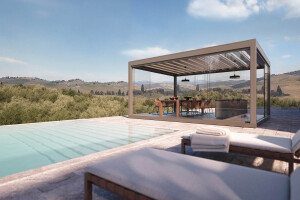Interloop, by artist Chris Fox, hangs from Wynyard station ceiling, hovering above the escalators that travel underground from York Street. The vast twisting accordion-shaped sculpture reconfigures the heritage escalators that once stood there in a stitched form. Suspended between two ends of the building, Interloop measures more than fifty metres in length, weighs over five tonnes, and weaves in 244 wooden treads and four combs from the original escalators. Whilst paying homage to the past, it also, simultaneously, looks forward to the future.
First installed in 1931, the historic timber-escalators - which have served Sydney's commuters for over eight decades - held a sense of time, journeys, and travel before they were removed this year. Interloop resembles, in part, the original escalators: important for Fox is creating an otherworldly space above people’s heads. The artwork explores the idea that people are stationary on an escalator whilst also travelling, allowing for a moment of pause that occurs mid-motion. The sculpture resonates with people in this state, referencing all those journeys that have passed and are now interlooping back.
A major milestone for Sydney and for Transport for NSW, who commissioned the large-scale sculptural project, Interloop provides an important legacy, helping to maintain and celebrate the historic identity of the city, while also looking to its future.
Site-specific sculpture unveiled in Sydney CBD’s Wynyard Station suspended above a bank of escalators
Australian contemporary artist and sculptor Chris Fox has today unveiled a major site specific installation suspended from the ceiling above a bank of escalators inside Wynyard Station in Sydney’s CBD.
The work, titled Interloop, is a hovering sculpture that loops together two pairs of reconfigured heritage escalators measuring more than 50 metres in length and incorporating 244 wooden escalator treads and 4 escalator combs from the historic Wynyard escalators.
Artist Chris Fox commented: “Connecting yesterday and tomorrow, ‘Interloop’ interrogates the conceptual and material boundaries between art and architecture. It is a physical re-interpretation of the historic wooden-stepped Wynyard escalators initially built in 1931, that re-purposes the hardwood from the heritage treads of now retired escalators, into a sculpture weighing over five tonnes.”
Taking 6 months to design and engineer, the sculpture took 12 weeks to fabricate with over a kilometre of welding, before an intensive 48-hour installation period. Interloop is built from high strength marine grade aluminium and suspended via new steel beams installed into Wynyard Station. The wooden treads from the original escalators have been refastened to the accordion like aluminium surface.
Interloop floats above the heads of commuters as they travel on the escalators linking York Street to the main concourse level of Wynyard Station.
With the re-purposing of the wooden treads the sculpture aims to evoke memories of passengers and modes of travel from the past while conjuring complimentary ideas of journey and travel, start and finish, here and there, as well as past and future.
Recent responses to some questions:
How long did it take to create the artwork?
Taking 6 months to design and engineer, the sculpture took 12 weeks to fabricate with over a kilometre of welding, before an intensive 48-hour installation period. Interloop is built from high strength marine grade aluminium and suspended via new steel beams installed into Wynyard Station. The wooden treads from the original escalators have been refastened to the accordion like aluminium surface.
What does the artwork represent?
Interloop reconfigures the heritage escalators in a stitched form, suspended between two ends of the building. The project signifies the past and future journeys that have occurred at this site. The old escalators had been there for over eighty years and before they were removed they held this sense of time and journeys, of time and travel. Interloop resembles, in part, the original escalators but something else is occurring, too: there’s this otherworldly space that occurs above people’s heads. Also, I wanted to explore the idea that people are stationary on an escalator whilst also travelling. The escalator allows for a moment of pause that occurs mid-motion. I wanted the sculpture to resonate with people in this state, to reference all those journeys that have passed and are now interlooping back.
Were there any particular challenges you faced during construction?
At the point when we were just about to start fabrication in August a strict timeframe for installation was decided with a 48-hour installation over one weekend, rather than over a couple of weeks, as we initially thought. We had to go back to the drawing board and rethink completely how we were doing this project: key was having pre-assembled parts that would bolt together efficiently on site.
What does it mean to you to have worked on quite an iconic piece of Sydney (the escalators) and have turned them into something that has become iconic itself?
The Wynyard escalators are a particularly unique material, as they are connected to the history and identity of our city. It was extraordinary to work with a material that holds so many memories and past journeys. It’s very exciting for Transport for NSW to commission such a large-scale iconic sculptural project. Ambitious visual arts projects as part of our urban infrastructure, are crucial in creating an identity for the city and enriching the experience of Sydney.
What does it mean to you to win a National Trust Heritage Award?
This project sets an wonderful precedent for heritage interpretation, where an artist can work in a poetic and flamboyant way yet hold the reverence for this extraordinary heritage material. To allow people to pause and think of something other that is occurring above them: for the public to know that there have been other journeys and other stories that have occurred in this important location. I think, if anything, it’s about pulling people out of their everyday.
















































